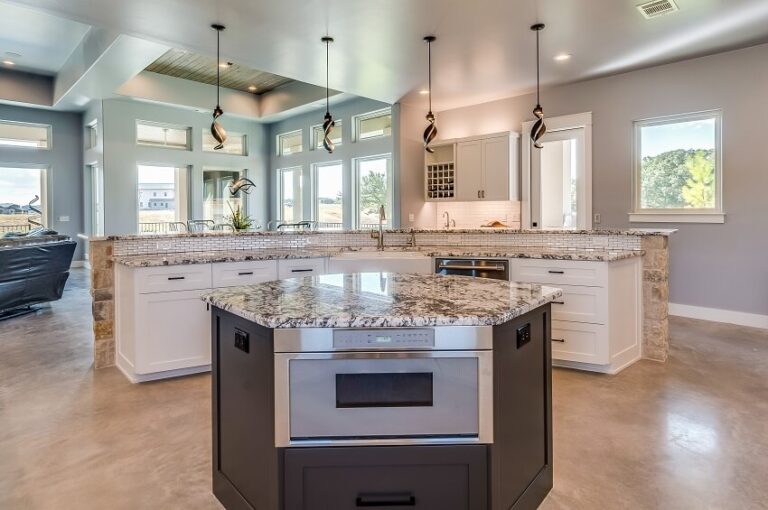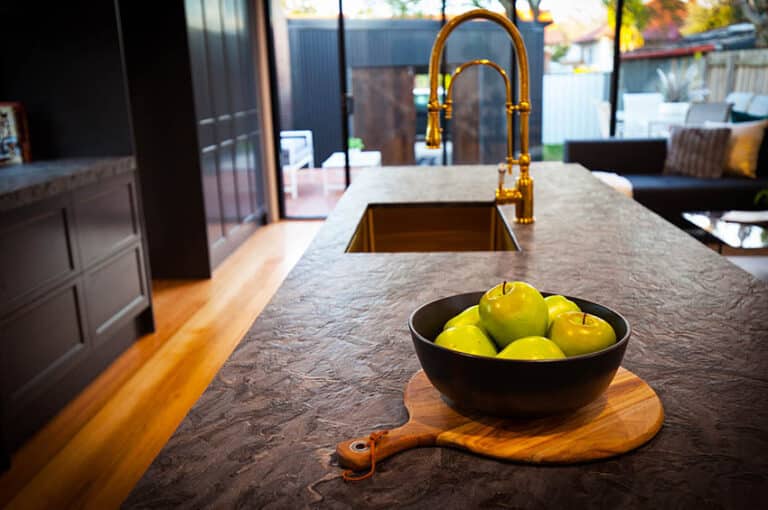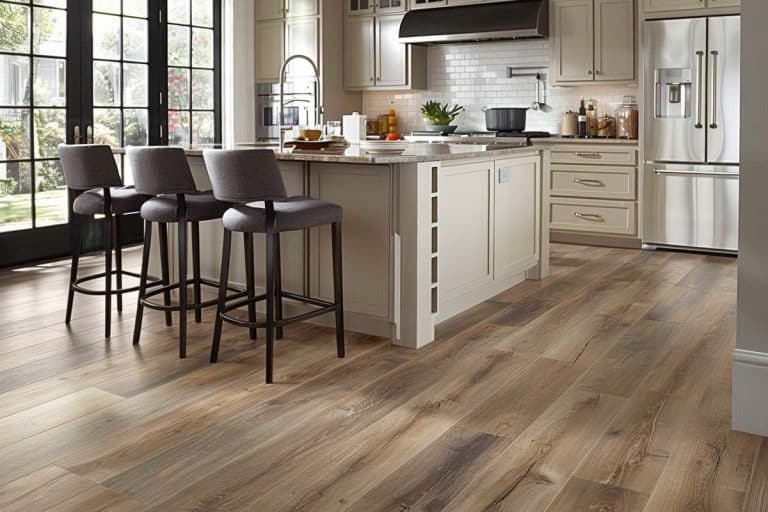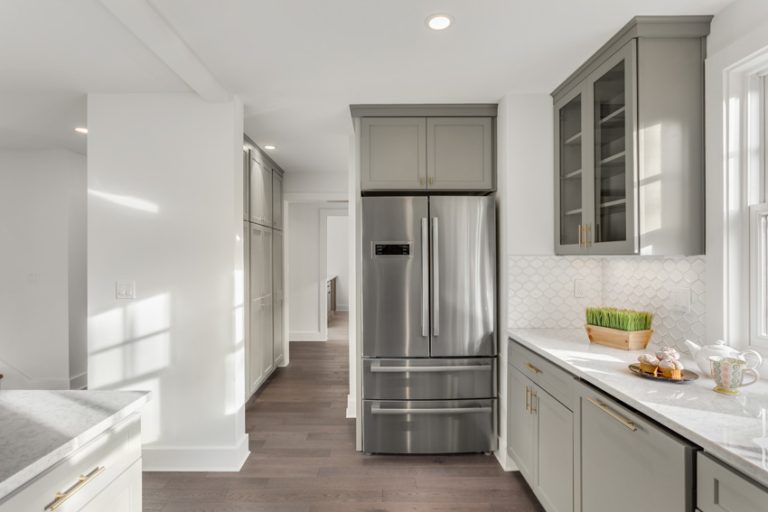Quartzite vs Marble Comparison (Countertops Design Guide)

There is so much similarity between marble and quartzite in appearance that many people mistake one for the other. These two natural stones have much to offer in visual appeal, durability, and performance. Regardless of the countertop material you choose, both marble and quartzite are reliable and worthy of being a part of your home. Below, we cover the comparison of quartzite vs marble and some tips on the best way to care for your countertops.
Differences Between Quartzite and Marble
While quartzite can look similar to granite and marble, there are very distinct differences. Here is a look at their different characteristics:
What is Marble?
Marble is a type of non-foliated metamorphic rock composed of recrystallized minerals like calcite, dolomite, calcium carbonate, or calcium magnesium carbonate. Marble starts as a mineral, specifically limestone or dolostone (limestone with dolomite), and then transforms into a new mineral with the help of a natural process that involves heat and pressure.
This process alters the texture and structure of the initial carbonate rock and gives the marble a very distinct appearance. If the original carbonate minerals are pure, the result is a very pure white marble. However, if other minerals are present, the resulting surface will have veins and swirls of colored variations. Both marble and quartzite are primarily non-foliated stones, which means they do not have layers or bands of mineral crystals.
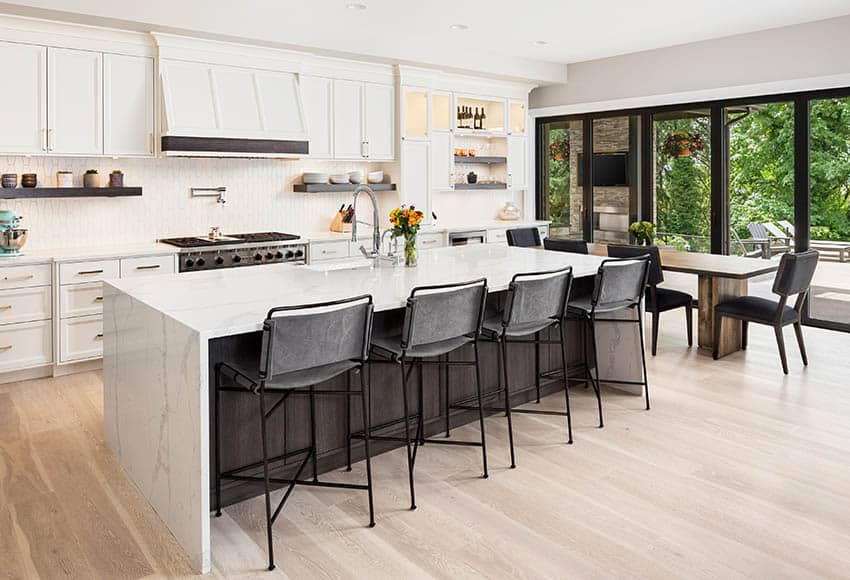
What Is Quartzite?
Quartzite is a type of naturally occurring non-foliated metamorphic rock primarily composed of recrystallized quartz crystals. It starts as a sedimentary rock, specifically a quartz-rich sandstone, and is transformed into a new rock (quartzite) through a metamorphic process involving high heat and extreme pressure.
The process alters the structure, texture, and appearance of the initial sandstone incrementally and gradually, therefore giving quartzite various appearances. If the sandstone has high quartz content, the result is a pure quartzite that is typically white or gray. However, if there are other minerals present, the resulting quartzite will have color variations.
Formation of Quartzite and Marble. Both marble and quartzite are metamorphic rocks, which means they undergo change via heat and pressure. They both started out as different kinds of material that get transformed into a new rock as it undergoes a metamorphic process.
However, the big difference between their formation lies in the initial material that they come from — quartzite comes from a sedimentary rock (quartz sandstone), while marble comes from a mineral (dolostone or limestone). The initial material that they come from contributes mainly to their distinct appearances and properties.
Location of Sources. Marble is typically sourced in Italy, Spain, China, Mexico, Turkey, Argentina, Poland, Ireland, Canada and the United States. In the US, marble is typically sourced from Alabama, Colorado, Georgia, Tennessee and Vermont.
Quartzite is mined in Italy, Pakistan, Norway, South Africa, Sweden, the Czech Republic, South Africa, Australia, United Kingdom, Canada and the United States. In the US, quartzite is typically found in Eastern States like Pennsylvania and New York, but it is also sourced from Arizona, Idaho, Minnesota, South Dakota and Wisconsin.
Comparison of the Characteristics of Quartzite to Marble
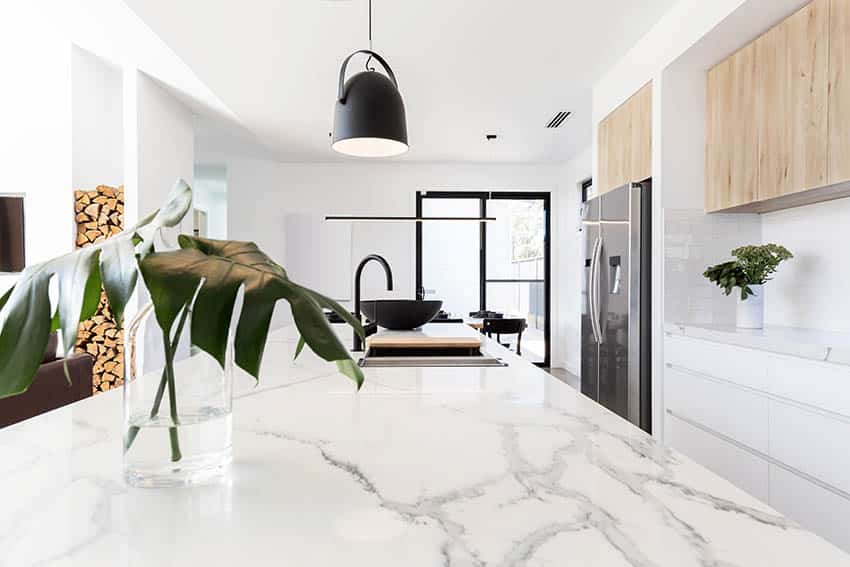
Material Composition. Marble is a mineral made up of calcite, whereas quartzite is made up of a sedimentary rock called quartz sandstone.
Appearance and Beauty. The biggest similarity between marble and quartzite is their appearance. They look very much alike and in fact, can be a bit difficult to tell apart at first glance. They have the same visual texture which is characterized by a crystallized appearance when viewed closely. Their distinct appearance is also characterized by graceful veins that flow in a neutral colored base.
When it comes to beauty, quartzite, and marble are closely on par with each other. Most homeowners are drawn to quartzite and marble because of their elegant, stylish, and luxurious appeal. They work well for classic and traditional settings but are also suited for contemporary settings because they are neutral toned materials. Overall, their look and feel are very much the same.
Texture. The texture of marble and quartzite are very much alike. The calcite found in marble is in crystal form, which allows the surface of the stone to be polished in a high gloss finish. The distinct shiny texture of marble makes it one of the most desirable materials used in countertops and flooring.
On the other hand, the sandstone in quartzite naturally has a grainy surface and a sandpaper like texture. But just like marble, quartzite can also be polished to a smooth, glassy shine.
Hardness. Quartzite is much harder than marble. The most important difference between quartzite and marble is the hardness of the stone. Their relative hardness greatly affects other properties such as their porosity, durability, and overall performance as a countertop material.
On the Mohs hardness scale, quartzite has a rating of 7, while granite measures only around 3. The reason for the big difference in their hardness is the minerals that each stone is composed of.
Quartzite is entirely made up of quartz which is considered to be the hardest material on earth. Marble, on the other hand, is relatively soft because it is made up of calcite.
Porosity and Moisture Resistance. Marble is more porous than quartzite. Since marble is a softer stone than quartzite, it is more porous and more susceptible to stains and watermarks. However, this does not mean that quartzite is completely bulletproof to water damage.
It is, after all, a natural stone and is naturally porous to some extent. Both countertop materials need sealing to ensure that no liquid penetrates their surface.
Color Variation and pattern. Quartzite and marble can be typically found in lighter shades of neutral colors. The purest form of quartzite is generally white and pale gray in color. Majority of quartzite slabs have light to heavy patches of gray, while some have different striations which give them a slight difference from marble.
Aside from white and gray, quartzite is also available in different color variations, depending on the random mineral present in the stone. For example, red and pink quartzite has iron oxide in them. Other less popular colors of quartzite available are blue, green, yellow, orange, black and brown.
Marble is usually a light colored stone. Its purest form is white in color, but it comes in different shades, too, depending on the impurities or minerals present in the stone. Its most popular color is white with gray veins. You can also find rare and exotic types of marble that are black, brown, yellow, green and blue in color.
Overall, the colors of marble and quartzite are very close. Their pattern is highly characterized by veining.Because of the limited colors that they come in, quartzite and marble is more preferred as countertops for kitchens with a neutral color palette.
Customization and Installation. The softness and hardness of the stone contribute to the level of workability and customizability of it as a countertop material.
Both marble and quartzite can be cut according to a specific size. However they require different tools and equipment during fabrication and installation. The reason for this difference is once again their material make- up. Calcite is what makes marble easy to work with, while quartz is what makes quartzite hard to manipulate.
Marble, being a softer material, is easier to customize. It can be easily shaped and smoothed — this being the same reason as to why most sculptors use it as their medium. However, when it comes to fabricating marble countertops, specific tools like diamond blades and marble saw blades are required to cut it.
In addition to the right tools, the proper bonding agent is also a critical choice. The glue must blend with the color of the marble countertop to ensure that there are no visible seams.
Quartzite, being a very dense and hard material, requires more special cutting tools, such as a diamond bridge saw, during fabrication and installation. If you use normal cutting blades, you’ll need to make multiple passes to cut the stone, making the process longer and more tedious. Quartzite is more brittle and requires more caution in cutting, grinding and drilling.
Durability. Quartzite is more durable than marble. If durability is your determining factor for your countertop material, quartzite is the perfect material to choose. As we have mentioned earlier, quartzite is one of the densest natural stones in the world, which also makes it a very reliable, durable and strong countertop material.
Because it is much harder than marble, it is less susceptible to regular wear and tear and is much less prone to damages like stains, scratches and chipping.
In addition to its inherent durability, quartzite is heat resistant, scratch resistant, fire resistant and UV resistant. Quartzite can withstand heat very well — putting a hot pan on it will not damage it. It also does not get scratched if you use a knife directly on its surface.
Lastly, quartzite countertops are also suitable for use in outdoor applications because they are resistant to UV rays. It will not fade or discolor even if it is exposed to direct, natural light.
Marble, in its own right, is also structurally durable. It will not wear and tear easily, but because of its relative softness and porosity, its durability is affected to some extent. It is more prone to stains, etches and damages.
Countertop Maintenance. Marble countertops require more maintenance because it is more porous. Softer stones simply need more care and would require more sealing to protect them from the wear and tear of daily use.
However, this does not mean that quartzite countertops would not need any care at all. Both of them, being natural stones, need to be sealed and resealed periodically to ensure that they last for years.
Even though marble countertops are reliable, they must be cared for and maintained properly. On a regular basis, you can use a cleaner that is specifically designed for use on marble surfaces.
The calcite in marble is very sensitive to acidic substances and most household cleaners can cause surface etching and can make marble countertops look dull. For this reason, you have to find a neutral cleaning agent that will not harm your stone.
Periodic and regular sealing is also a given for marble countertops. Sealing the stone will prevent any liquids from seeping through the surface and will prevent etching, discoloration, and dulling.
Quartzite countertops, on the other hand, are much easier to clean on a daily basis. You only need a cloth with warm water and soap to wipe its surface. But you also need to be careful because it is sensitive to abrasive cleaners like bleach.
It can also get damaged by acidic substances as some quarzite slabs contain some amount of calcite, the same mineral found in marble. As mentioned earlier, quartzite is a natural stone that needs to be initially sealed and periodically sealed with an impregnating sealer every 6 to 12 months.
Resale Value. Ultimately, having natural stone countertops can give your home increased value. Potential buyers are drawn to having natural stone countertops as part of their home because they not only have a distinct natural beauty but also offer a lot of practical benefits.
However, marble countertops have an edge over quartzite countertops when it comes to resale value. Despite the dramatic rise in popularity of other countertop materials, marble remains the most prized natural stone in the market.
The primary reason for this is its stunning appearance and history. Some marble varieties, such as the Calacatta and Statuario have beauties which are unparalleled and simply breathtaking.
Comparison of Marble Versus Quartzite Stone Video
Quartzite Cost Vs Marble Cost
Most people assume that marble is more expensive compared to other countertop materials because of its reputation as the most prestigious natural stone in the market. However, this is not always the case because its prices vary depending on its type and variety.
The average cost for marble slab countertops is $60 per square foot. You can find inexpensive marble countertops for as low as $40 per square foot, while the high end varieties can range from $100 or more per square foot.
One of its most popular varieties, Carrara marble, is very affordable and is sold at around $40 per square foot. Another popular variety — the Statuario is available at $50 per square foot and is, in fact, cheaper than quartzite.
On the other end of the spectrum, you find one of the most expensive natural stones in the market, which is the Calacatta marble which is priced at around $180 per square foot.
The average cost for quartzite slab countertops is a little more expensive at $90 per square foot. The price of quartzite countertops ranges around $60 to $100 per square foot, but prices can go beyond that if the type and design of the stone is more exotic.
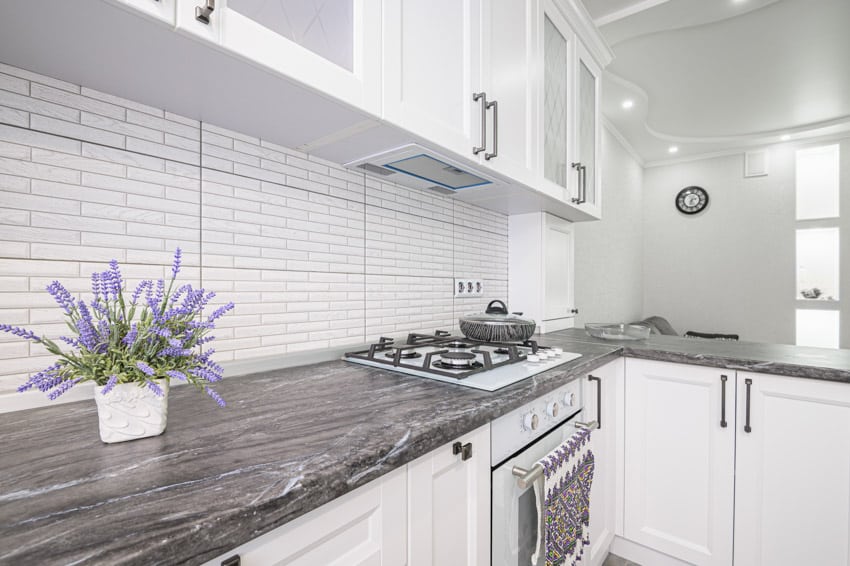
Does Quartzite Etch Like Marble
Etching is one of the most dreaded problems with some natural stone countertops. Natural stones that have calcium carbonate in them produce a chemical reaction when they come in contact with acidic substances. This results in “etching” — a type of surface damage that leaves a dull mark on the countertop.
Etching is one particular flaw common to marble because it is primarily made up of calcite or calcium carbonate. In order to protect it from such, marble needs to be treated with sealers.
Although very durable, some (not all) quartzite slabs can be prone to etching, especially those that have calcium carbonate in them. But compared to marble, it is not easily damaged by common acidic substances.
How can you prevent etching? There are some effective ways to prevent etching in marble countertops. First, know all the common household items which have a high acid content such as lemons, sodas, ketchup, and some cleaning products. In case of spilled liquids, wipe immediately using a damp cloth.
Another preventive measure is periodic stone sealing or the regular application of a stone sealer to protect your countertop from substances that can possibly deteriorate the calcite in them.
Typically, an impregnating sealer is applied to the countertop once every 3 to 6 months. Another way to protect from etching is to regularly use a fortified stone polish. This product also contains sealers, which help maintain the shine of the stone.
Etching can either be mild or deep. Mild etching only leaves a dull spot, but the texture of the stone remains to be smooth. Deep etching, on the other hand, makes the stone look cloudy and leaves a rough feel on its surface.
There are several ways to treat these, and one of the most common ways to remove the dull spot in a natural stone countertop is to use an etch remover. Mild etching can also be removed using polishing powder. Deep etching, on the other hand, can only be repaired with the help of a stone restoration professional.
How To Tell The Difference Between Quartzite Compared To Marble
It can be quite hard to tell marble and quartzite apart because of their remarkable resemblance with each other. In fact, it is nearly impossible to tell the difference just by looking at them.
There have been unfortunate cases wherein stone suppliers pass off marble for quartzite, and this can translate to issues in the future because they have different material compositions that require specific maintenance procedures.
So, how can you determine if the stone is quartzite or marble? Aside from making sure that you buy from a reputable and experienced stone supplier, there are two reliable ways you can use to distinguish a quartzite slab from a marble slab:
- Scratch test – The easiest way to know you’re looking at quartzite or marble slabs is to do a scratch test. Since these two natural stones have different degrees of hardness, one is more prone to scratches than the other.
To do this, simply ask your supplier if you can perform the scratch test using a piece of glass, a key, or nail to test the hardness of the stone. If you are using a small piece of glass, lay it on a flat surface. Then, with high force, scratch the glass using the edge of a small piece of stone. If the glass scratches, you have quartzite, but if the stone crumbles, you have marble.
- Acid Test or Etch Test – The acid test or etch test is another way to determine if a stone slab is marble or quartzite. The acid test works because the minerals that make these stones produce different reactions to acidic substances. As previously mentioned, calcite or calcium carbonate — the main component of marble is more sensitive to acids than quartz — the main component of quartzite.
To test if a slab is pure marble, pour a small amount of acidic liquid like vinegar or lemon juice on a small piece of scrap stone. Let it sit for about 10 to 20 minutes. If the surface of the stone becomes “etched,” faded or dull looking, this means that you have marble. Whereas if there is no reaction, the stone is quartzite.
Granite Vs Marble Vs Quartz Vs Quartzite
Choosing the right material for your countertop can be quite confusing because of the numerous options available in the market. From natural stones like granite, marble, and quartzite, to engineered quartz slabs, each of these options has its own properties, which make them better than the other.
If you are facing the challenge of deciding which one is the right option for your home, it helps to have a comprehensive guide of the characteristics of these countertop materials. You can also try visiting a local stone manufacturer’s showroom.
There, you can ask questions, see up close the different patterns, touch and feel the materials, and potentially speak with designers about your remodel project.
We would love to hear what you think about quartzite vs marble countertops. Do you have a favorite? If so, let us know in the comments below.
For more information on the characteristics of quartz and its detailed comparison to quartzite, head on to our official guide Quartz Vs. Quartzite. You can also visit our page on Quartzite Vs. Granite to find out more about the remarkable characteristics of these two natural stones.


